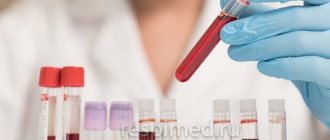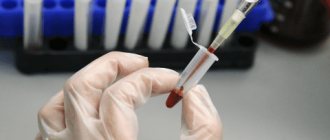Detailed description of the study
Activated partial thromboplastin time is an indicator reflecting the state of one of the stages of blood coagulation.
In clinical practice, the determination of this indicator is most often used to monitor the state of the blood coagulation system in patients receiving antithrombotic drugs (for example, heparin). In addition, it is recommended to conduct an APTT study before any planned surgery in order to promptly identify possible abnormalities in blood coagulation processes and avoid complications. APTT is an important test for diagnosing certain blood diseases (hemophilia, von Willebrand disease, etc.).
Prolongation of APTT above normal values indicates hypocoagulation (tendency to bleeding) and can be caused by:
- administration of heparin;
- severe liver diseases, in which the synthesis of proteins involved in blood clotting is disrupted;
- lack of vitamin K (many blood clotting factors are vitamin K dependent);
- congenital deficiency of certain blood clotting factors;
- antiphospholipid syndrome (a disease in which a large number of antibodies to components of cell membranes are detected in the blood);
- presence of hemophilia;
- the second stage of DIC syndrome (a sharp disruption of all blood coagulation processes, observed in many critical conditions: shocks, severe injuries, burns, massive thrombosis, etc.).
A shortened APTT indicates a tendency to thrombus formation and can be associated with thrombosis of any location, as well as with some hereditary diseases characterized by an increased risk of thrombus formation. The reason for the shortened APTT may be the first stage of DIC syndrome
Activated partial thromboplastin time, or APTT , is the time it takes for a blood clot to form after calcium chloride and other reagents are added to the plasma. It reflects the work of the so-called internal pathway and the general cascade of the human blood coagulation system and is the most sensitive indicator of blood coagulation.
The duration of APTT depends on the level of high molecular weight kininogen, prekallikrein and coagulation factors XII, XI, VIII and is less sensitive to changes in the amount of factors X, V, prothrombin and fibrinogen. APTT is determined by the duration of blood clot formation after calcium and partial thromboplastin are added to the blood sample. Prolonged aPTT (indicating hypocoagulation) can be observed with deficiency of factors XII, XI, X, IX, VIII, V, II or fibrinogen, liver diseases, vitamin K deficiency, the presence of heparin, lupus anticoagulant, the presence of pathological inhibitors of fibrin polymerization (for example, myeloma proteins) or other clotting inhibitors. APTT usually changes when the level of any of the factors decreases below 30 - 40% of normal. A shortened APTT indicates increased coagulation (hypercoagulation). This indicator is used separately to monitor therapy with direct anticoagulants (heparin).
Material under study
Deoxygenated blood
Interpretation of research results contains information for the attending physician and is not a diagnosis. The information in this section should not be used for self-diagnosis or self-treatment. The doctor makes an accurate diagnosis using both the results of this examination and the necessary information from other sources: medical history, results of other examinations, etc.
Units: Sec. (second)
Reference values: 24–35 sec
3.What are the risks and what may affect the analysis?
Risks of PTT analysis
If you are taking a blood test for PTT, then possible risks may only be associated with taking blood from a vein. In particular, the appearance of bruises at the site of blood sampling and inflammation of the vein (phlebitis). Warm compresses several times a day will relieve phlebitis. If you are taking blood thinning medications, you may bleed at the puncture site.
What can affect the PTT analysis?
APTT/PTT tests do not have any serious limitations, however, if you are taking certain medications, this may affect the result. Consult your doctor before the test.
Method of determination
This procedure is quite common, so patients do not have any difficulties or problems with it. The main biological material for determining thrombin time is blood. The resulting biomaterial sample is placed in a special laboratory tube with sodium citrate. This chemical compound has the ability to bind calcium ions, which prevent clotting. Then the tube with the resulting blood is sent to a centrifuge, after which plasma with a minimum number of platelets is obtained. To activate the intrinsic coagulation pathway, an activator (for example, kaolin) and phospholipids are added to the plasma sample. After this, a solution of calcium chloride is added to the biological material, which helps to utilize the anticoagulant effect obtained by citrate). The final stage of this procedure is to measure the time until a blood clot forms. It is this indicator that is fundamental for assessing health status. Regardless of whether the APTT is increased, decreased or within normal limits, the laboratory worker always displays the results obtained on the appropriate form. If the name of the test contains the word “partial,” this indicates the absence of tissue factor in the reagents used.
Analysis transcript
As a rule, after taking the test, the results will be ready within 1-3 business days. They can be sent by email, given to the attending physician, or collected from the laboratory in person. The finished form indicates the APTT value, and next to it is a table with normal readings (sometimes reference values in different laboratories may differ slightly), thanks to which you can compare your result with the norm. It is important to note that the received form does not provide a diagnosis or prescribe medical recommendations. The patient receives only the result of the analysis, which is further evaluated by the doctor. Typically, thromboplastic time is not assessed separately. In most cases, an extended coagulogram is prescribed, which includes this indicator. APTT may be normal, increased or decreased, which is a symptom of a pathological process.
When is the study scheduled?
APTT is an important component of diagnosis. It is actively used to confirm a large number of diseases and prevent the development of life-threatening situations:
- Hemophilia and other bleeding disorders (eg, von Willebrand disease);
- Monitoring the condition of the patient who is undergoing treatment with heparin and hirudin;
- Identification of the cause of myocardial infarction and search for optimal treatment tactics;
- Suspicion of acute leukemia (may be an additional diagnostic criterion);
- Search for the cause of bleeding of unknown etiology (including after childbirth or surgery);
- Monitoring hemostasis in pregnant women, identifying the causes of miscarriages and infertility;
- Preparation for surgery (non-compliance of thrombin time with the norm is a contraindication to the start of surgery).
DIC syndrome , deserves special attention . This pathology represents the activation of coagulation mechanisms, which results in increased thrombin formation. This leads to the formation of microthrombi in microvessels - the hypercoagulation phase. After this, with a high degree of probability, a transition phase develops, which is characterized by impaired microcirculation. Active formation of fibrin leads to activation of fibrinolysis, which begins to surpass coagulation. This is the hypocoagulation phase, during which the risk of bleeding increases greatly. It occurs due to depletion of coagulation factors during the period of hypercoagulation. By eliminating the etiology of DIC (taking certain medications, poisoning, and much more), it is possible to normalize the body’s condition and prevent undesirable consequences. In the absence of timely intervention, a decompensation phase occurs, which is characterized by blockage of blood vessels. As a result of this, blood does not flow to the organ, tissue necrosis occurs and bleeding resumes due to complete incoagulability of the blood.
Norm and interpretation of results
The common unit of measurement for the test is the clotting time in seconds.
In Russia, the standard range of values is considered
- 21.1-36.5 sec
Reference values of the Invitro laboratory Invitro values are somewhat different from the standard ones, since the more modern equipment of this laboratory allows measurements to be taken with greater accuracy.
- Norm for APTT: 25.4-36.9 sec
In Western medicine, more generalized values are considered normal:
- 30-40 sec
An increase in aPTT time indicates a risk of bleeding, and a shortening indicates a risk of thrombus formation.
APTT test during pregnancy
A hematologist and gynecologist can prescribe this test as part of a coagulogram if the expectant mother has a tendency to thrombosis or bleeding.
Pregnancy complications can occur due to natural processes:
- hormonal changes;
- the formation of the third circle of blood circulation (uteroplacental), which delivers oxygen and nutrients to the embryo;
- changes in the hemostatic system before and after childbirth.
Important!
In pregnant women, the level of another coagulogram indicator, fibrinogen, increases, reaching a maximum of 6 g per 1 liter (2 g more than normal).
At the same time, the APTT begins to decrease and reaches a normal value of 17-20 seconds.
When the thromboplastin time is shortened relative to the specified norm, the risk of developing thrombosis increases (the blood thickens). Thrombosis can affect the vessels of the placenta and cause its premature detachment. Also, APTT does not significantly deviate from the norm while taking iron supplements (prescribed to the expectant mother with low hemoglobin).
Prolongation of APTT in pregnant women (blood thins) can cause uterine bleeding, which threatens the life of the expectant mother and child.
Also, blood clotting disorders during pregnancy increase the risk of developing disseminated intravascular coagulation syndrome. In the 1st phase, blood clots are actively formed, and in the 2nd and 3rd phases the blood practically does not clot, which can cause severe blood loss.
To prevent the development of complications, it is necessary to do a coagulogram with APTT determination every trimester.
Unscheduled tests are prescribed for pregnant women in the following cases:
- presence of coagulation pathologies in the family history;
- liver dysfunction;
- diseases of the cardiovascular system;
- hypertonicity of the uterus (threat of miscarriage);
- hypertonic disease;
- proteinuria (presence of protein in urine);
- increased tissue swelling;
- gestosis (complication of toxicosis of the 3rd trimester).
Preparation for delivery
The results may be unreliable due to the influence of factors such as taking certain medications, exposure to thromboplastin due to significant injury to the vein, and much more. To prevent such situations, the patient is recommended to follow simple preparatory measures:
- 7-14 days before donating blood, stop taking medications (if possible, after agreement with your doctor);
- 7 days before taking biological material, avoid alcoholic beverages and coffee;
- 1 day before taking biomaterial, limit sports activities;
- In the morning before the examination, refrain from smoking;
- 30 minutes before the procedure, you can drink a glass of clean water without gas.
It is important to note that thrombin time testing is not indicated for women during the menstrual period, since hormonal changes occurring at this time may change the reliable data.
APTT is one of the most important laboratory indicators, the determination of which makes it possible to completely diagnose even small deviations from the norm. This test makes it possible to identify most bleeding disorders (especially hemophilia, which has been diagnosed in a large number of people in recent years) and begin therapy in the early stages, preventing the development of severe and even life-threatening consequences. At the MedArt clinic you can take an APTT test and get reliable data in the shortest possible time. The information received must be passed on to the attending physician, who will be able, based on the information received, to make an accurate diagnosis and draw up a plan for further treatment.
Complexes with this research
Pregnancy planning.
Clinical indicators RUR 3,880 Composition Examination during pregnancy. 1st trimester 10,390 RUR Composition
Extended coagulogram Extended study of the functional state of hemostasis 2,730 R Composition
IN OTHER COMPLEXES
- Entry into IVF RUB 15,030
- Miscarriage RUB 29,050
- Coagulogram RUR 1,110
- Female infertility RUB 9,790
- Examination during pregnancy. 3rd trimester 5,730 RUR






